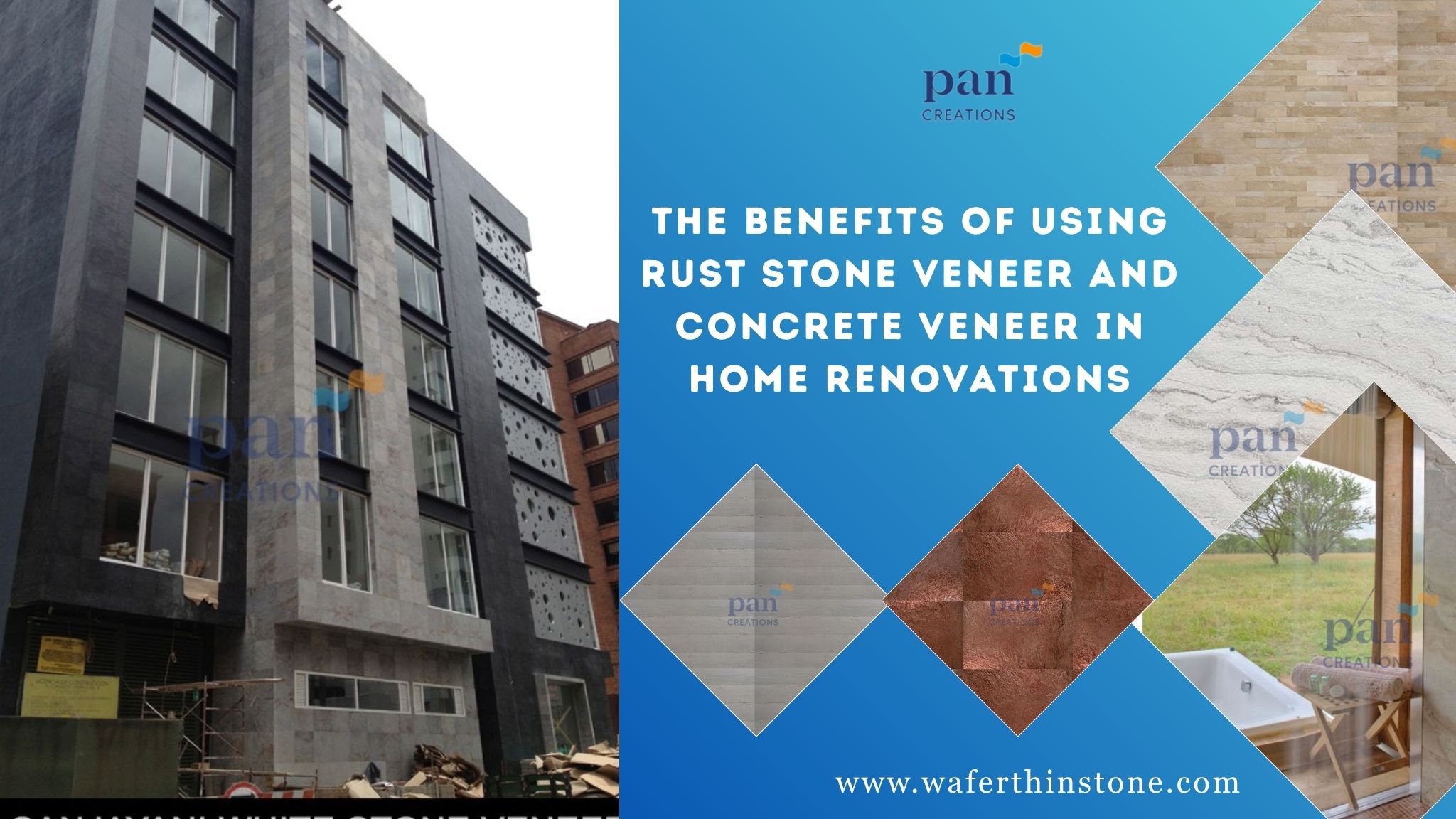Home renovations demand materials that balance aesthetics, durability, and ease of application. Among the options available, natural and engineered veneers stand out for their ability to mimic high-end finishes without the associated costs. These thin layers adhere to existing surfaces, allowing homeowners and contractors to achieve professional results efficiently. In particular, materials like rust stone veneer and concrete veneer offer distinct advantages suited to contemporary design needs. Contractors often select them for projects where visual impact must align with practical constraints such as budget and timeline.
Veneers transform ordinary spaces into refined environments. They apply directly over substrates like drywall or masonry, reducing structural modifications. This approach minimizes disruption during installation, a key consideration for occupied homes. Industry professionals value veneers for their versatility across interior walls, fireplaces, and exterior facades. As renovations prioritize sustainability and low maintenance, these materials gain prominence in residential upgrades.
What Is Rust Stone Veneer?
Rust stone veneer consists of thin slices of natural rust-colored stone, typically sandstone or slate with iron oxide deposits that create warm, earthy tones. Sourced from quarries, it undergoes processing to achieve flexibility while retaining the stone’s authentic texture and color variations. This material suits renovations seeking organic warmth in living areas or entryways.
Manufacturers like Pan Creations produce rust stone veneer in sheets that conform to curved surfaces, expanding design possibilities. The veneer’s natural composition ensures it withstands environmental factors better than painted alternatives. Homeowners appreciate its subtle patina development over time, which enhances rather than detracts from the overall look.
Key Benefits of Rust Stone Veneer
Incorporating rust stone veneer into renovations yields several operational advantages. Its lightweight nature, often under two pounds per square foot, simplifies handling and transport, cutting labor costs by up to 30 percent compared to full-thickness stone. This efficiency allows crews to complete installations in days rather than weeks.
Durability forms another core strength. Rust stone veneer resists fading from UV exposure, making it ideal for sunlit interiors or patios. In high-humidity zones like bathrooms, it prevents mold growth due to its non-porous treatment options. Contractors report fewer callbacks for maintenance, preserving project profitability.
From a design standpoint, rust stone veneer integrates seamlessly with wood accents or metal fixtures, fostering cohesive schemes. Its modular panels enable precise cuts for custom layouts, reducing waste and supporting eco-conscious builds. Businesses handling multiple renovations benefit from its consistent availability, streamlining supply chains.
Practical Applications for Rust Stone Veneer
In kitchen backsplashes, rust stone veneer provides a tactile contrast to glossy countertops, elevating functionality with heat resistance up to 400 degrees Fahrenheit. Installers secure it with thin-set mortar over tile underlayment, achieving a seamless edge finish.
For accent walls in home offices, this veneer absorbs sound waves effectively, improving acoustics without additional panels. A standard 10 by 12 foot space requires about 120 square feet of material, installed in under eight hours by a two-person team.
Exterior uses include gable ends on ranch-style homes, where rust stone veneer weathers gracefully alongside siding. Its breathable structure allows moisture escape, preventing efflorescence issues common in denser claddings.
Understanding Concrete Veneer
Concrete veneer refers to precast or poured thin layers that replicate the raw, industrial aesthetic of poured concrete. Composed of cement aggregates and polymers, it offers a uniform gray palette with optional texturing for depth. This material excels in renovations aiming for minimalist or urban vibes.
Producers engineer concrete veneer for flexibility, enabling it to wrap columns or irregular forms. Its factory-controlled curing process ensures color consistency across batches, a reliability factor for larger projects.
Key Benefits of Concrete Veneer
Concrete veneer delivers cost savings through rapid curing times, often ready for foot traffic within 24 hours of placement. This accelerates renovation schedules, enabling earlier occupancy and reduced rental losses for flippers.
Strength ratings exceed 5,000 psi in compression, surpassing many natural stones and supporting load-bearing applications like stair risings. In seismic zones, its ductility absorbs shocks better than brittle alternatives.
Sustainability appeals to green builders, as concrete veneer incorporates recycled aggregates, lowering embodied carbon by 20 percent. Maintenance involves simple pressure washing annually, preserving its matte finish without sealants.
Aesthetic adaptability shines in mixed-use spaces, where concrete veneer pairs with glass partitions for light diffusion. Its neutral base accepts stains for custom hues, tailoring to client specifications without overhauls.
Practical Applications for Concrete Veneer
Basement conversions benefit from concrete veneer on foundation walls, masking imperfections while adding insulation value through air pockets in the mix. Application over foam board achieves R-13 ratings, complying with energy codes.
In outdoor kitchens, it forms durable counter surrounds resistant to grill heat and spills. Panels interlock without grout lines, facilitating self-leveling pours on uneven slabs.
Living room media walls use concrete veneer to frame built-in shelving, creating focal points that ground eclectic decor. Wiring conduits embed easily during installation, future-proofing electronics setups.
Comparing Rust Stone Veneer and Concrete Veneer
Selecting between rust stone veneer and concrete veneer depends on project goals. Rust stone veneer favors warm, textured environments like rustic dens, while concrete veneer suits sleek lofts with its clean lines. Both install similarly over primed surfaces, but stone requires more precise alignment to highlight veining.
Cost analysis shows rust stone veneer at $8 to $12 per square foot installed, versus $6 to $10 for concrete veneer, factoring in material and labor. Longevity metrics indicate both last 50 years with proper care, though concrete edges out in freeze-thaw cycles.
Environmental profiles differ: rust stone veneer scores high on renewability from quarries, and concrete veneer on recyclability at end-of-life. Contractors mix them in zoned designs, using stone for hearths and concrete for surrounds.
Installation Best Practices for Both Materials
Preparation starts with substrate assessment. Clean surfaces free of contaminants, then apply bonding agents suited to the veneer type. For rust stone veneer, use latex-modified thinset; for concrete veneer, opt for polymer emulsions.
Cutting tools include wet saws for stone and angle grinders for concrete, ensuring dust control with vacuums. Back-buttering panels guarantees full adhesion, preventing delamination over time.
Finishing involves joint filling with color-matched caulk, followed by 48-hour curing under plastic sheeting. Test samples in situ to verify color under ambient lighting, adjusting as needed.
Post-installation, ventilate areas to off-gas any additives, and schedule inspections for adhesion pull tests meeting ASTM standards.
Maintenance and Longevity in Renovated Homes
Routine care for rust stone veneer includes annual soft-brushing with mild soap to remove surface dust. Avoid abrasives that dull the natural sheen. In coastal settings, quarterly rinses combat salt buildup.
Concrete veneer withstands power washing at 1,500 psi, restoring vibrancy without etching. Seal edges biennially to block efflorescence, extending service life.
Both materials resist pests and fire, with Class A ratings per NFPA 701. Track performance via annual photos, addressing cracks under 1/8 inch promptly with epoxy fillers.
Integrating Veneers with Pan Creations Services
Pan Creations specializes in flexible veneers tailored for Indian and global markets, ensuring compliance with international building norms. Their export-ready products arrive pre-cut, minimizing on-site adjustments.
Consulting with Pan Creations early in planning refines material choices, drawing from their 20-year expertise in slate and aggregate formulations. Bulk orders qualify for volume discounts, optimizing budgets for multi-unit renovations.
Conclusion
Rust stone veneer and concrete veneer elevate home renovations through proven performance and design flexibility. By prioritizing these materials, contractors deliver enduring results that satisfy clients and enhance property values. As industry standards evolve, their role in sustainable practices will only grow, making them essential tools for forward-thinking projects.
Must Read: How Concrete Veneer Panels and Flexible Stone Veneer Transform Modern Spaces
Frequently Asked Questions
Q1. What makes rust stone veneer suitable for curved surfaces?
Ans: Rust stone veneer derives its flexibility from thin slicing and backing layers, allowing it to bend up to 90 degrees without cracking. This property suits arches or rounded columns in renovations.
Q2. How does concrete veneer compare to traditional poured concrete in cost?
Ans: Concrete veneer costs 40 to 60 percent less than poured options due to thinner profiles and prefab elements, while delivering similar visual and structural outcomes.
Q3. Can rust stone veneer be used outdoors?
Ans: Yes, rust stone veneer performs well in exteriors with weatherproof sealants, resisting rain and temperature swings common in temperate climates.
Q4. Is concrete veneer eco-friendly for renovations?
Ans: Concrete veneer incorporates up to 50 percent recycled content, reducing quarry demands and supporting LEED certification in green builds.
Q5. How long does installation of these veneers typically take?
Ans: For a 200-square-foot area, rust stone veneer or concrete veneer installs in two to three days, depending on surface prep and crew size.

